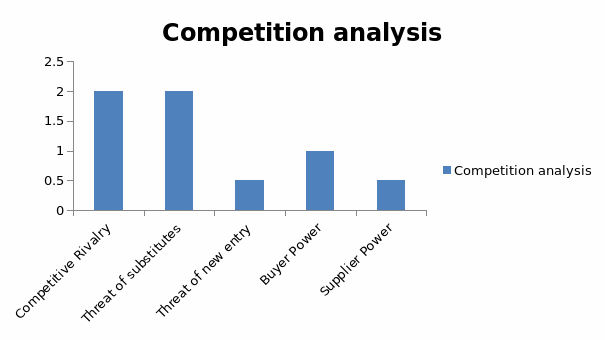The Five Forces Model of Competition Analysis

The five forces analysis of the rental movie industry shows that threats:
- Substitutes- high
- Competitive rivalry- high
- Threat of new entry- low
- Buyer power- medium
- Supplier power- low
In the rental movie industry, substitutes and competitive rivalry present serious threats to a company’s profitability in the rental movie industry. Buyer power presents a medium threat, while threats involving supplier power and new entry cannot affect a company’s market position in the rental movie industry.
Competitive rivalry
In 2008, the rental movie market in the United States stood at $ 9.5 billion. Although Netflix, presently, is the market leader in the industry with 6.3 million subscribers as at 2009, if faces fierce competition from Blockbuster and new entrants such as Wal-Mar and Intelliflix. The competition essentially encompasses price wars that have seen Netflix lose some of its customers to its rival, Blockbuster.
Threat of Substitutes
Netflix’s subscription can be substituted in a number of ways. Customers can obtain movies from rental stores, cable companies, DVD renting kiosks and movie theatres. Thus, the substitution for subscription is easy and hence a considerable threat.
Threat of New Entry
Netflix’s elaborate distribution systems and economies of scale make it increasingly difficult for new entrants to operate in the industry. Thus, new entry presents a lesser threat to Netflix’s market position.
Buyer Power
Netflix’s subscription is mostly online, thus, individually, the customers have less power to influence the company’s market position.
Supplier Power
Netflix and its suppliers benefit mutually from agreements and partnerships involving movie studios. They have a revenue sharing agreement. Thus, supplier power has little impact upon the company’s performance.
Key Driving forces in the Industry
Among the key success factors in the rental movie industry, is the cost. Affordable movies that offer customers value for their money will attract more customers. The capacity to offer a convenient service promptly also influences customers in the industry. In addition, the ability to offer a large variety of movies especially of new releases is another key success factor in the industry. Advanced technology and elaborate distribution systems would also ensure success in the industry as they play a role in meeting customer needs.
Netflix’s Competitive Strategies
- Allows members to watch over 7000 movies online
- Provides a wide selection of movies that suit customer
- Keeps track of rented movies by customers
- Makes DVD recommendations to customers
- Offers a free 2 week trial for new customers
Blockbuster’s Strategies
- Offers 2 free movie DVDs monthly
- Allows conversion of an online order to a local store order
- Allows new subscribers to pay $9.99 subscription only during the first month.
SWOT Analysis for Blockbuster
Strengths
- Offers both movie and video game rentals
- Has an elaborate delivery system; rental stores, internet and downloading kiosks
Weaknesses
- The distribution systems are not efficient
- Declining brand reputation
Opportunities
- Expanding market in game renting
- Blockbuster total access technology and video streaming
Threats
- Stiff competition from other players
- Rapid technological changes
Industry Revenues and Income in 2006 & 2007
The total revenue for Blockbuster for the last quarter of 2006 was $ 1.51 billion and rose to $ 1.57 billion for the fourth quarter of 2007 representing a 3.6 % increase. The net income for 2006 was $8.3 million and improved to $38.1 million in 2007. Netflix’s gross sales for 2006 stood at $966.7 million and rose to $1.205 billion in 2007. Its net income was $48.84 million and rose to $66.61 million in 2007.